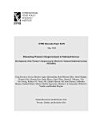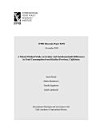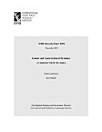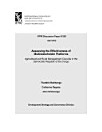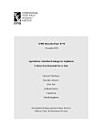Nutrition-sensitive agriculture diversification and dietary diversity: Panel data evidence from Tajikistan
Takeshima, Hiroyuki · Lambrecht, Isabel · Akramov, Kamiljon · Ergasheva, Tanzila
apr 2024. · IFPRI Discussion Papers 2249. knjiga · Intl Food Policy Res Inst
E-knjiga
48
Broj stranica
family_home
Prihvatljiva
info
reportOcjene i recenzije nisu potvrđene Saznajte više
O ovoj e-knjizi
Nutrition-sensitive agricultural diversification continues to receive interest among developing country stakeholders as a viable option for achieving dual goals of poverty reduction and food/nutrition security improvements. Assessing the effectiveness of this strategy is also essential in countries like Tajikistan. We attempt to enrich the evidence base in this regard. We assess the linkages between household-level agricultural diversification and dietary diversity (both household- and individual-levels) using unique panel samples of households and individual women of reproductive ages in the Khatlon province. Using difference-in-difference propensity-score methods and panel fixed-effects instrumental variable regressions, we show that higher agricultural diversification together with greater overall production per worker and land at the household level leads to higher dietary diversity, particularly in areas with poor food market access. Typology analyses and crop-specific analyses suggest that vegetables, fruits, legumes/nuts/seeds, dairy products and eggs are particularly important commodities for which a farmer’s own production contributes to dietary diversity improvement. Furthermore, decomposition exercises within the subsistence farming framework suggest that nutritional returns and costs of agricultural diversification vary across households, and expected nutritional returns may be partly driving the adoption of agricultural diversification. In other words, households’ decisions to diversify agriculture may be partly driven by potential nutritional benefits associated with enhanced direct on-farm access to diverse food items rather than farm income growth alone. Our findings underscore the importance of supporting household farm diversification in Tajikistan to support improved nutrition intake, especially among those living in remote areas. In a low-income setting with limited local employment opportunities that is vulnerable to a wide range of external shocks, this will likely continue to be one of the most straightforward and realistic paths to improving household’s nutrition resilience.
Ocijenite ovu e-knjigu
Recite nam šta mislite.
Informacije o čitanju
Pametni telefoni i tableti
Instalirajte aplikaciju Google Play Knjige za Android i iPad/iPhone uređaje. Aplikacija se automatski sinhronizira s vašim računom i omogućava vam čitanje na mreži ili van nje gdje god da se nalazite.
Laptopi i računari
Audio knjige koje su kupljene na Google Playu možete slušati pomoću web preglednika na vašem računaru.
Elektronički čitači i ostali uređaji
Da čitate na e-ink uređajima kao što su Kobo e-čitači, morat ćete preuzeti fajl i prenijeti ga na uređaj. Pratite detaljne upute Centra za pomoć da prenesete fajlove na podržane e-čitače.




